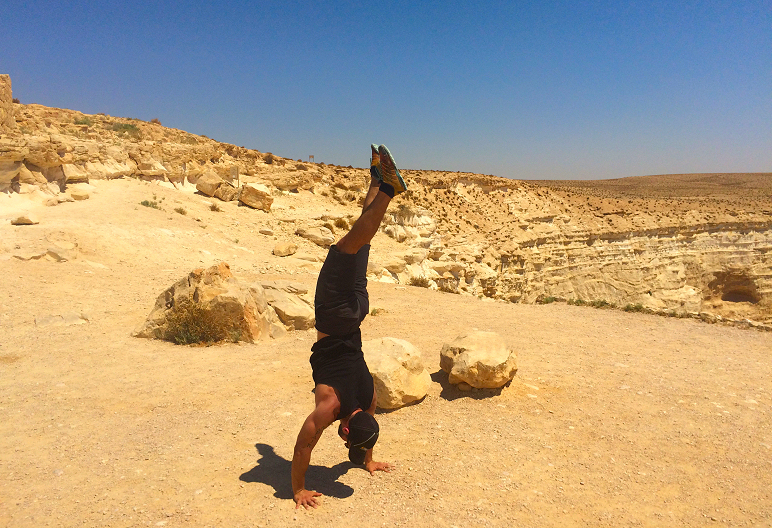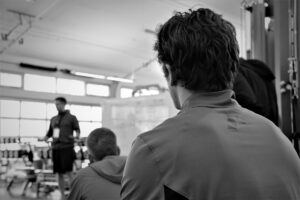Why you should train without music, at least some of the time:
Distraction is the norm. When was the last time anyone had dinner alone in lieu of any media outlet? My favorite is when I see two people dining together and one gets up to use the restroom: The other person left alone does not sit in silence but instead is quick like wildfire to grab their phone in order to browse the time away until their friend comes back. I am guilty of this myself. Being completely alone with our thoughts is scary. However, our CrossFit workouts are also scary, and yet we underscore the importance of conquering that fear one repetition at a time. Therefore, I propose killing two birds with one stone by conquering your next workout without music—just you, banging weights, and your breath. Stop trying to distract yourself from the workout and start enjoying every sweat dropping point in time.
Let your workout be your time of deep practice: practice that involves forcing you to slow down and struggle just enough to take you to that next level of understanding. How many times mid competition workout have you missed that clean and continued to hammer away at it unsuccessfully? Perhaps, there was a hole in your training: a lack of time spent training not just to endure but to course correct. It has been my experience, coaching clients and as an athlete, that periodic dosages of music-less workouts can promote more purposeful training sessions in contrast to surviving the “grind.”
At least before the met-con portion of the day, I mainly coach group classes without music because I want to set the environment for a time of attentiveness that would be found in a martial arts dojo. Since the music has been off up until the point of the WOD, I am frequently asked to put the music on when starting the clock for the WOD because he or she asking does not want to listen to him or herself breathe. It took me a few times hearing this reason behind the request for music before I finally started to contemplate the severity of such a statement. As coaches, we are constantly telling our clients to breathe, especially during a high-intensity workout. This advice becomes moot if the client is actively trying to drown out the sound of their own breath. Quality movement is the reflection of quality proprioception (spatial awareness); however, one is proprioceptively compromised if one’s interoception (perception of internal organs) is being kept prisoner. Yoga teacher Judith Lansater (2015) writes, “the body expresses ‘thoughts’ through movement and the mind expresses ‘movement’ through thoughts,” (p. 78). Our thoughts and our breath are an integral part of what are body is capable of, especially under the high stake scenario of a CrossFit workout. For instance, Cindy (20 min AMRAP: 5 pull ups, 10 pushups, 15 squats) at a first glance is not overbearing. However, those of us who have done it can vouch for the toll high volume reps place on the body in later rounds.
Let us temporarily assume a stark dichotomy: there are two ways one can approach Cindy. You can either turn the music up and simply, one dimensionally “get to work.” Or, you can embrace the external environment of ambient noise in lieu of music and tap into the whirlpool of thoughts and breath patterns that overwhelm you in a state of metabolic struggle. Instead of conditioning yourself to be numb to any internal sensations in order to get the task done, how about you create an environment that enhances your ability to become finely tuned to the entire spectrum of internal stimuli? Therefore, you become free to choose a fate that involves progress more nuanced than the binary did you PR—yes or no?
The reality is that there are never only two approaches to a workout. Can someone have music playing and still reap the benefits of “deep practice”? Of course. This is not a discussion of right or wrong, good or bad. I love music. Those that know me well know that I love music more than most. However, similar to the ways in which one’s program fluctuates between heavy days and light days, Olympic weightlifting days and met-con days, high volume days and low volume days, I offer up distinctively deciding for music days and non-music days.
Like Carl Paoli uses blocked movement patterns (e.g., feet together burpee) in order for one to more assuredly map and experience an anatomically ideal position, I am using and suggesting the absence of music to help one zoom in on the plethora of intangibles that make a training session such a meditative, and spiritual experience.
Do not just learn to love hearing your own breath, learn to love hearing your breath in harmony with your friends and family whom you are training with. Better yet, train outside: on a beach, in a forest, at a playground, if you are lucky, in front of a waterfall! Make your training session more than just another distraction, or a “to-do” needing to be checked off for the day. Make your training session a time of sanctuary. If nothing else, be like OG CrossFitter Josh Everett who says, “if you need music to motivate you, go find something else to do,” (https://www.youtube.com/watch?v=xsT_TanV0eo).




